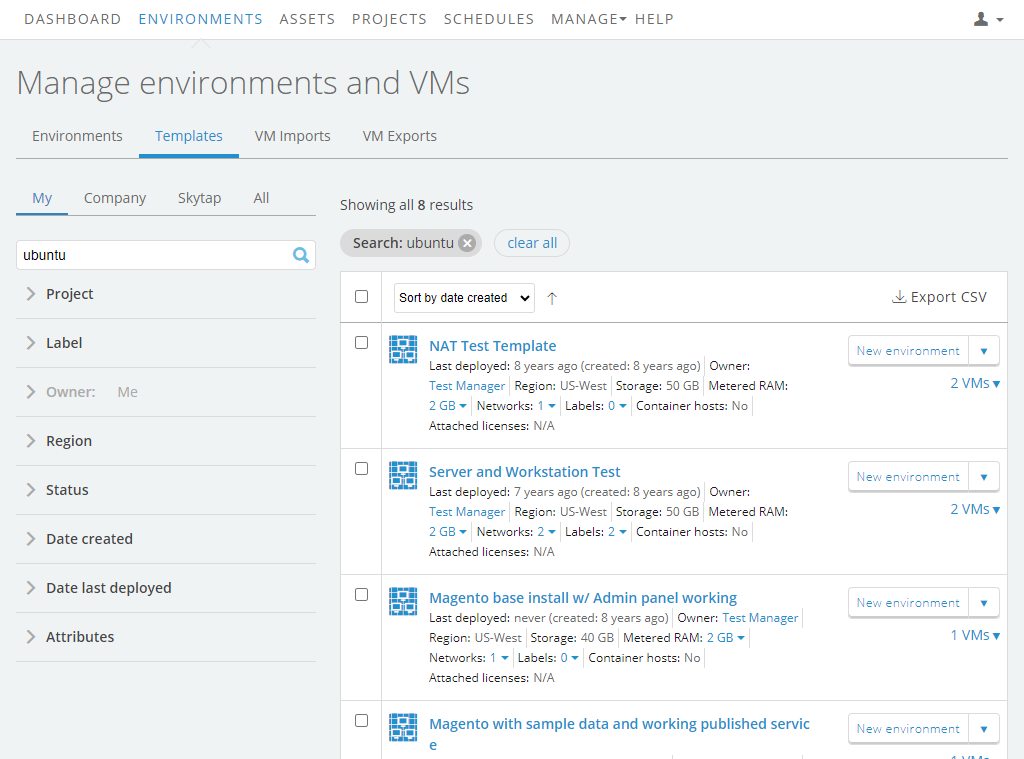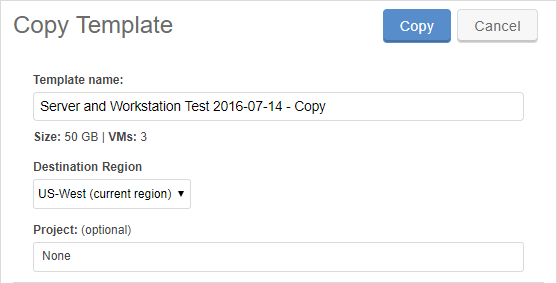Copying a template
Copying a template is a powerful action in Skytap. With just a few clicks, you can quickly copy an entire, complex template, including the VMs, networks, and template settings. If you need to work with templates in multiple regions, you can easily copy the template to each region.
By default, the copied template is placed in the same region as the source (original). To copy a template to another Skytap region, see Copying a template to another region.
After you’ve copied a template, changes to the copied template don’t affect the source template. The source and copy are unlinked, separate resources.
Contents
Copying a template in the same region
- From the navigation bar, click Environments. Click the Templates tab.
- Click
 (More options) next to the template you want to copy.
(More options) next to the template you want to copy.

- Click Copy Template.
-
The Copy Template window displays. The current region is selected as the Destination Region. To copy to another region, see Copying a template to another region.

Optionally:
- Edit the Template name.
- Select a Project for the new template. For more information about projects, see Sharing resources with projects.
- Click Copy.
- The detail page for the new template displays, but you can’t interact with it until the process is complete.
- If you leave the copy page or sign out of Skytap, the copy process continues automatically. sends you an email when the copy process is complete.
- Generally, copying an environment in the same region is faster than copying an environment across regions. For more information, see What to expect when you copy an environment or template.
Changes to a template during the copy process
For the most part, a copied template is a duplicate of the original. Almost all of the template settings (notes, labels, etc.), VM settings (MAC addresses, hostnames, CPUs, storage, etc.), and network settings (network subnet, gateway IP address, etc.) remain the same.
There are only a few places where the copy differs from the original. For templates, these changes are visible when you create a new environment from the copied template.
| Setting | Change to copied template |
|---|---|
| Published services | Skytap creates a new published service that maps the same internal port to a new external port address. For example: Port 80 open at services-uscentral.skytap.com:12345changes to: Port 80 open at services-uscentral.skytap.com:78901 |
| Sharing portals | Skytap creates sharing portals for the new template with the same settings and new, unique access links. |
| Public IP addresses | Static public IP addresses – The VM in the new template has the same public IP address attached to it. When the same static public IP address is attached to multiple VMs, only one of these VMs can run at a time. Dynamic public IP addresses with DNS – Skytap automatically generates a new, unique domain name for the VM in the new template. When the VM next runs, Skytap automatically assigns an available public IP address. |
Canceling a copy operation
To cancel the copy operation, click Delete on the right side of the progress bar.